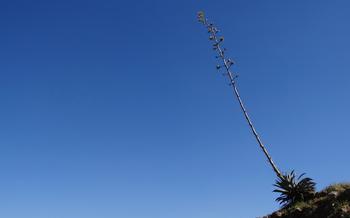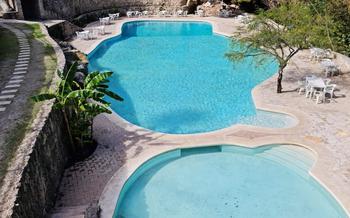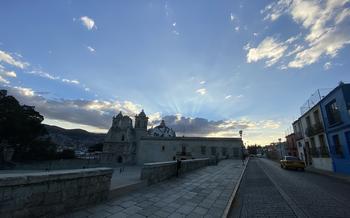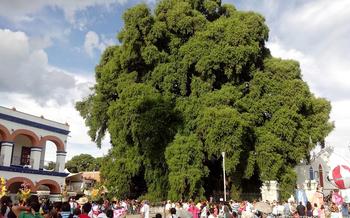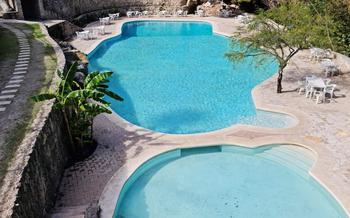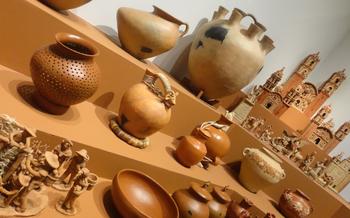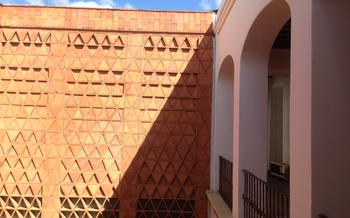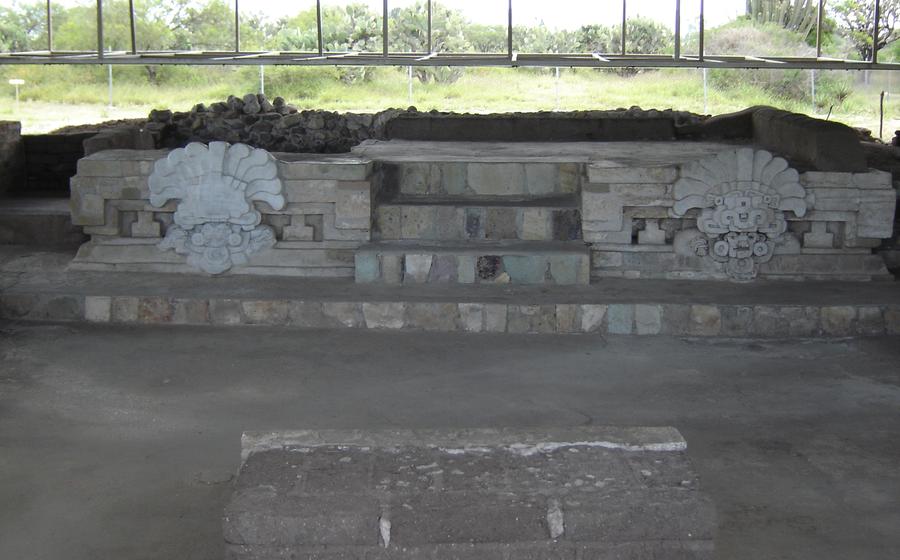
Lambityeco Archaeological Site
- Historical Significance
- Getting There:
- Exploring the Site
- Monte Albán: A Majestic Neighbor
- Zapotec Ball Game:
- Hieroglyphs and Inscriptions:
- Ceramics and Artifacts:
- Restoration and Conservation Efforts:
- Local Traditions and Culture
- Surrounding Landscapes:
- Photography and Videography
- Gastronomy and Local Cuisine
- Cultural Events and Festivals
- Insider Tip: Unraveling the Secrets of the Ancient Zapotec Observatory
Historical Significance
The Lambityeco Archaeological Site, nestled in the picturesque Tlacolula Valley, holds a significant place in the tapestry of Mexico's rich history. Once a thriving Zapotec city, Lambityeco played a crucial role in the pre-Columbian era, serving as a religious, political, and economic hub. Its strategic location allowed the Zapotecs to control trade routes and expand their influence throughout the region. After centuries of prosperity, the city was abandoned around the 15th century for reasons still shrouded in mystery. In the 20th century, Lambityeco was rediscovered, revealing a treasure trove of ancient Zapotec artifacts, structures, and inscriptions. Today, ongoing archaeological research and excavations continue to shed light on the fascinating history of this ancient city, offering glimpses into the lives and culture of the Zapotec people.
Getting There:
To reach the Lambityeco Archaeological Site, you can embark on a 30-minute drive from Oaxaca City, the state capital. It's conveniently located just 15 kilometers from the city center. If you prefer public transportation, regular buses depart from Oaxaca's main bus station, offering an affordable and scenic journey. The site is also accessible by guided tours, which often include transportation from Oaxaca City and provide insightful commentary along the way. For those who enjoy the freedom of self-driving, the well-maintained roads leading to Lambityeco make it an easy and enjoyable drive. Whether you choose to go solo or join a tour, plan to spend a full day exploring this ancient Zapotec city and immersing yourself in its rich history and cultural significance.
Exploring the Site
As you step into the Lambityeco Archaeological Site, you are transported back in time to the ancient Zapotec civilization. The site is divided into several areas, each with its own unique structures and features. Start your exploration at the main plaza, where you can admire the impressive pyramids and temples that dominate the landscape. The architecture here showcases the Zapotec's mastery of construction and their deep connection to the cosmos.
Next, head to the residential area, where you can see the remains of ancient homes and workshops. These structures provide a glimpse into the daily life of the Zapotec people, their domestic activities, and their skilled craftsmanship. Don't miss the ball courts, where the ancient Zapotec game of pelota was played with great skill and passion. The size and design of these courts speak to the importance of the game in Zapotec culture.
Continue your exploration to the ceremonial center, where you can marvel at the intricately carved stelae and altars that stand as silent witnesses to Zapotec religious beliefs and rituals. These monuments often depict Zapotec rulers, deities, and mythical creatures, offering insights into their spiritual world.
As you wander through the site, take the time to appreciate the unique features and architectural styles that set the Zapotec culture apart. From the corbelled arches and vaulted roofs to the elaborate friezes and bas-reliefs, every detail showcases the creativity and ingenuity of this ancient civilization.
Monte Albán: A Majestic Neighbor
Just a short distance from Lambityeco lies another archaeological gem, Monte Albán, the ancient capital of the Zapotec civilization and one of the most important pre-Columbian cities in Mesoamerica. While Lambityeco offers a glimpse into the early history of the Zapotecs, Monte Albán represents the height of their power and influence.
In comparison to Lambityeco, Monte Albán is much larger and more complex, covering an area of over 40 square kilometers and boasting monumental structures such as the Great Plaza, the North Platform, and the Danzantes Building. The site is renowned for its sophisticated urban planning, including a grid system of streets and plazas, as well as its impressive architectural achievements, such as the carved stone lintels and friezes that adorn its buildings.
Despite their proximity, Lambityeco and Monte Albán had distinct roles and functions. While Lambityeco was likely a ceremonial and ritual center, Monte Albán served as the political, economic, and religious capital of the Zapotec empire. The two sites were closely connected, however, and evidence suggests that they shared cultural and economic ties.
Visiting both Lambityeco and Monte Albán offers a comprehensive understanding of the Zapotec civilization. While Lambityeco provides insights into the origins and early development of the Zapotecs, Monte Albán showcases the grandeur and complexity of their empire at its peak. Together, these two archaeological sites offer a fascinating journey through the history and culture of one of Mesoamerica's most influential civilizations.
Zapotec Ball Game:
The ancient Zapotec ball game, known as "Juego de Pelota," was a ritualistic sport that held deep cultural and religious significance for the Zapotec civilization. Played on specially designed stone courts, such as the one found at Lambityeco, the game involved two teams competing to keep a large rubber ball in play by hitting it with their hips, elbows, or knees. The rules and gameplay were complex, and the outcome of the game was believed to have spiritual implications, often related to fertility, rain, and the success of agricultural cycles. The ball game was not merely a sport but a sacred ritual that symbolized the struggle between opposing forces and the cosmic balance.
Hieroglyphs and Inscriptions:
Lambityeco is home to a wealth of Zapotec hieroglyphs and inscriptions, offering valuable insights into the history and culture of this ancient civilization. These inscriptions, etched into stone slabs and monuments, provide a glimpse into the Zapotec language, their system of writing, and their rich mythology and beliefs. Archaeologists and epigraphers are continuously working to decipher and translate these inscriptions, shedding light on the political, social, and religious aspects of Zapotec life. Each symbol and glyph holds a story, revealing the names of rulers and dynasties, recording historical events, and offering prayers and dedications to the Zapotec gods. By studying these inscriptions, we gain a deeper understanding of the sophisticated writing system and intellectual achievements of this ancient culture.
Ceramics and Artifacts:
Among the ruins of Lambityeco, a treasure trove of Zapotec ceramics, pottery, and artifacts awaits discovery. These relics provide a tangible glimpse into the daily lives, artistic traditions, and craftsmanship of this ancient civilization. From intricately painted vessels and figurines to finely crafted tools and ornaments, each artifact tells a story. The Zapotec were renowned for their skilled pottery, using a variety of techniques to create both functional and decorative pieces. Common motifs found in Zapotec ceramics include geometric patterns, animals, and human figures, often imbued with symbolic meanings. These artifacts offer valuable insights into the Zapotec worldview, their beliefs, and their connection to the natural world. Furthermore, they showcase the remarkable artistic abilities of this ancient culture, whose legacy continues to inspire contemporary Oaxacan artisans.
Restoration and Conservation Efforts:
The Lambityeco Archaeological Site, like many other ancient wonders, faces the challenge of preserving its rich history for future generations. Recognizing the importance of this heritage, ongoing restoration and conservation efforts are diligently undertaken to safeguard the site's integrity. Skilled archaeologists, conservators, and historians collaborate to meticulously restore the ancient structures, using traditional techniques and materials to maintain the site's authenticity.
Preserving the intricate Zapotec hieroglyphs and inscriptions is of utmost importance, as they hold valuable clues to the civilization's history and culture. Conservationists employ specialized methods to protect these inscriptions from erosion, decay, and vandalism, ensuring their legibility for years to come.
The restoration process also involves the careful excavation and study of artifacts, providing insights into Zapotec craftsmanship, daily life, and artistic traditions. These artifacts, once meticulously restored, are often displayed in local museums, allowing visitors to admire their beauty and significance.
By supporting these restoration and conservation efforts, visitors can contribute to the preservation of Lambityeco's legacy and ensure that this ancient Zapotec city continues to inspire and educate generations to come.
Local Traditions and Culture
The communities surrounding the Lambityeco Archaeological Site are steeped in vibrant local traditions and culture, deeply influenced by their Zapotec heritage. Zapotec customs, festivals, and daily life are still very much alive, adding a rich layer of authenticity to the region. Visitors have the opportunity to interact with local communities, learn about their traditions, and support sustainable tourism initiatives. The warmth and hospitality of the local people are renowned, and visitors are welcomed with open arms. Whether it's participating in traditional ceremonies, learning about Zapotec weaving techniques, or simply enjoying the lively atmosphere of local markets, there are countless ways to immerse oneself in the local culture and gain a deeper understanding of Zapotec traditions.
Surrounding Landscapes:
The Lambityeco Archaeological Site is nestled amidst breathtaking natural landscapes that offer a diverse array of flora and fauna. The surrounding hills and valleys are adorned with lush vegetation, including cacti, agaves, and various species of wildflowers. The site is also home to a variety of wildlife, including birds, reptiles, and small mammals.
Visitors can immerse themselves in the natural beauty of the region by embarking on a hike through the surrounding hills. The trails offer panoramic views of the archaeological site and the surrounding countryside. Birdwatching enthusiasts can spot a variety of species, including hummingbirds, parrots, and eagles. The site is also home to several caves and waterfalls, which offer unique opportunities for exploration and adventure.
When exploring the natural surroundings of Lambityeco, it is important to practice responsible and sustainable tourism. Visitors should stay on designated trails to minimize their impact on the environment, and avoid littering or disturbing the local wildlife. By embracing eco-friendly practices, travelers can help preserve the natural beauty and biodiversity of this unique region for future generations.
Photography and Videography
The Lambityeco Archaeological Site offers ample opportunities for photography and videography enthusiasts. With its stunning ancient structures, picturesque landscapes, and intricate artifacts, the site provides a rich visual tapestry for capturing memorable moments. For photographers, the golden hour, just after sunrise or before sunset, casts a warm and ethereal glow on the ruins, creating ideal conditions for capturing dramatic shots. Tripod use is permitted, allowing photographers to stabilize their cameras for crisp and clear images.
When photographing the site's architecture, experiment with different angles and perspectives to convey the scale and grandeur of the structures. Capture close-ups of the intricate carvings and glyphs to reveal the artistry and symbolism of the Zapotec culture. Don't forget to include the surrounding landscapes in your shots to provide context and a sense of place.
For videographers, the site offers a dynamic canvas for storytelling. Create sweeping aerial shots using a drone to showcase the vastness of the archaeological zone and its surroundings. Capture the movement of clouds over the ruins, the play of light and shadow on the stone surfaces, and the vibrant colors of the local flora and fauna. Interviews with local experts or guides can add depth and context to your videos, providing viewers with insights into the history and significance of Lambityeco.
Gastronomy and Local Cuisine
The region surrounding the Lambityeco Archaeological Site offers a unique and delectable culinary experience, deeply rooted in Zapotec traditions and flavors. Visitors can indulge in a variety of must-try dishes that showcase the region's rich culinary heritage.
One of the highlights of Zapotec cuisine is the use of fresh, local ingredients, including corn, beans, squash, and chili peppers. These ingredients are transformed into flavorful dishes that reflect the Zapotec way of life.
A must-try dish is tlayudas, large, crispy tortillas topped with refried beans, shredded meat, cheese, and a variety of salsas. Another local delicacy is mole negro, a complex and flavorful sauce made with over 20 ingredients, including chocolate, chili peppers, and spices.
For a taste of traditional Zapotec bread, try pan de yema, a sweet bread made with egg yolks and sugar. And don't miss out on the region's famous mezcal, a distilled spirit made from roasted agave.
To experience the authentic flavors of Zapotec cuisine, visit local markets or restaurants in the towns surrounding the Lambityeco Archaeological Site. Engage with local chefs and learn about the cooking techniques and ingredients that make Zapotec cuisine so unique.
Whether you're a foodie or simply looking for a taste of local culture, the gastronomy of the Lambityeco region is sure to tantalize your taste buds and leave you with lasting memories.
Cultural Events and Festivals
The region surrounding the Lambityeco Archaeological Site is renowned for its vibrant cultural events and festivals that showcase the rich Zapotec heritage. One of the most significant events is the Guelaguetza, held annually in July in the nearby city of Oaxaca. This festival is a celebration of indigenous culture, featuring colorful parades, traditional dances, music, and food. Visitors can witness the mesmerizing spectacle of hundreds of dancers in elaborate costumes performing traditional dances that have been passed down through generations.
Other notable events include the Day of the Dead celebrations in November, when communities come together to honor their deceased loved ones. Altars are adorned with marigolds, candles, and offerings, and families gather to share stories and memories of their ancestors. Visitors can experience this unique and poignant tradition by participating in local festivities, visiting cemeteries, and sampling traditional foods associated with the holiday.
Throughout the year, various smaller festivals and celebrations are held in the region, showcasing local traditions, crafts, and gastronomy. These events provide an excellent opportunity for visitors to immerse themselves in Zapotec culture and interact with the local community.
Insider Tip: Unraveling the Secrets of the Ancient Zapotec Observatory
Venture beyond the main archaeological zone and embark on a short hike to discover a hidden gem—the ancient Zapotec observatory. Situated atop a hill overlooking the valley, this sacred site offers a breathtaking panoramic view and a unique perspective into the astronomical knowledge of the Zapotec civilization. Imagine standing in the footsteps of ancient astronomers, marveling at the celestial alignments and the intricate relationship between the cosmos and their daily lives. This hidden treasure is a testament to the ingenuity and precision of the Zapotec culture and provides a deeper understanding of their connection to the natural world.
